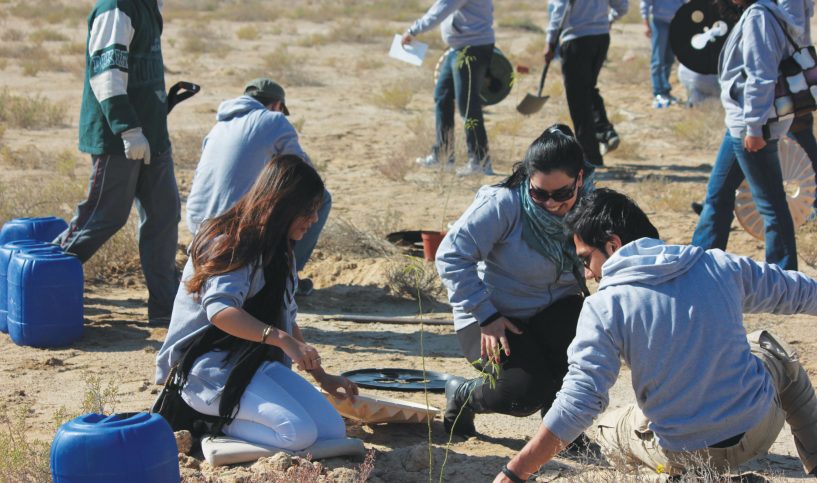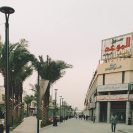You might have heard about people having green fingers, but here’s one that has a green dream. A civil engineer by profession, a butterfly-lover, a beach (rather than desert) person, an avid recycler, and founder of Kuwait Oasis – bazaar gets acquainted with Khaled Al Kulaib and his ambitious 315,000 tree-strong, Kuwait Green Wall Project.
What started in the late 90’s with two young men and a few trees, has today grown into an environmental NGO called Kuwait Oasis, Kuwait’s largest voluntary environmental initiative that advocates the importance of planting trees in the deserts of Kuwait. Having no background in horticulture, Khaled was just a concerned citizen, alarmed by the havoc wrecked on wildlife and fauna in the wake of the Gulf War. He helplessly watched as desert wildlife, migratory birds, and insects began to decline, and bareness grew wider.
Khaled has been planting trees individually for over a decade, but a few years back decided to take it a step further. He started by educating himself, referring to studies conducted by KISR and other environment bodies and gaining insight on the kind of trees that would be draught resistant and most beneficial to the desert-ecology. “The Arabian Peninsula has never been a good environment for trees, only for bushes,” explained Khaled. ”But there are some Acacia trees that migrated to the region not less than 400 years ago, and have created a generation that are draught resistant and can withstand the severe and harsh conditions. These are the types we plant in our oasis.”
We are all familiar with the adverse effect civil life has when it intrudes on wildlife. In a 2006 statistic by the Kuwait Municipality, there were more than 40,000 camps during the camping season i.e. from November until April. This was prior to the passing of the legislation that requires campers to pay a deposit for camping out in the deserts. While camping, Kuwait Oasis encourages campers to plant 10 trees and irrigate them during the winter season, which is also the incubation period for trees. By the end of the season, these trees will be able to survive in the wild.
In 2009, with the help of some business-chains along the highway, Kuwait Oasis managed to distribute their advocacy flyers to campers who shopped there. With media exposure, radio and TV interviews, Khaled has been rigorously spreading his idea, but unfortunately, there is no way to measure the outcome.
Now an active arm of Environment Voluntary Foundation (EVF), Kuwait Oasis team has spent two years doing extensive research, getting to know legislations conducive to their project, identifying people instrumental in planning, planting techniques, and various irrigation systems, which enabled them to introduce the Waterboxx technique of irrigation.
Kuwait Green Wall Project
Dubbed as National Project by EPA, Kuwait Green Wall Project was initiated in November last year, and is the largest in the history of environmental projects in the area. “We plan on planting three rows of an estimated 315,000 trees along the political borders of Kuwait. It will take us 10 years to accomplish our target and MOI has permitted us to plant behind the net fence, so that it’s protected from livestock feeding.”
Some naysayers seem to disapprove of the idea, saying that trees are foreign to desert-habitat and wasting a precious commodity like water is impractical. Khaled dismissed these claims, calmly stating, “We have done our study. So if anyone has an argument, they will have to prove their point.”
Naturally, Khaled’s team realizes the importance of water conservation. “That is why we switched to Waterboxx irrigation system, which is a Dutch technology,” he points out. “Previously, we used drip irrigation, wherein each tree consumed 20 liters of water per week. By utilizing the Waterboxx, now each tree consumes 30 liters per year.” A staggering 1500 liters per tree is conserved annually! The inventor of Waterboxx, Pieter Hoff, has himself worked closely with Kuwait Oasis since 2009, to incorporate this sustainable alternative to irrigation.
So, how does Kuwait Oasis plan on financing the Kuwait Green Wall project? “KGW does not accept either donations or sponsorship,” Khaled stated. He explains why it became important in the wake of the financial crisis to come up with an alternate solution, “not wanting to be a financial burden, we instead collaborate encouraging social responsibility and increasing public awareness. For example, one of our partners is Dar Al Shifa Hospital, for whom we created a model called ‘A Tree of Life’, which encourages new-parents to purchase a tree in their newborn’s name. They have more than 560 deliveries per month.” In exchange, Kuwait Oasis issues a certificate with the footprints of the baby, stating ‘that a tree has been planted’.
Similarly, they collaborated with Alghanim Automotive and while the purchase option is voluntary, it has shown unprecedented response from customers.
Explaining Incubation
The incubation refers to the irrigation of trees on a weekly basis for a period of 6 months and then letting them thrive on their own. “Camping season coincides with the incubation period,” said Khaled, explaining why educating campers was necessary. “If we could reach out to these campers and convince them to plant ten trees, we would be planting 400,000 trees per year. With chances of success rate being 60%, about 240,000 trees could find their way to life every year. The result would be a greener desert providing shade and refuge to birds and other wildlife.”
Successes and Setbacks
In 2010-11, Kuwait Oasis planted 5000 trees in three different oases in the deserts of Kuwait. Notable ones include VIVA Oasis with 4000 trees, Nathan’s Oasis with 500 trees, and an oasis of 680 trees by individual contributions. Collectively, these oases cover an area of 10 sq.kms and can be viewed on Google Earth.
Though they deemed it a considerable success, there were a few setbacks too. “Kuwait Municipality has permitted us to plant in areas where livestock feeding is restricted,” Khaled explained, and voicing his concern that trespassing still remains an imminent treat, he added, “in 2011 there was some problem between Kuwait agriculture authority and livestock owners as a result of which they breached the area where we had planted and nearly all trees that had grown to 1.5m height were grazed to the ground.”
The success of Kuwait Oasis has created an affiliated programme called Doha Oasis and an inspired a movement in Jordan now sponsored by Queen Rania. “Trees planted today, will tomorrow be our children’s oasis,” concluded Khaled.
Cost of donating a tree: Each tree costs a nominal KD 20, which includes the Waterboxx (sustains two trees), manpower, fertilizers, tools, and maintenance cost for a period of 3 years.
Get involved: Donate online or become a volunteer by filling out a form on their website. For more information, log on to www.kuwait-oasis.com or www.facebook/kuwaitoasis.








